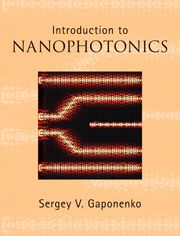Book contents
- Frontmatter
- Contents
- Preface
- Notations and acronyms
- 1 Introduction
- Part I Electrons and electromagnetic waves in nanostructures
- 2 Basic properties of electromagnetic waves and quantum particles
- 3 Wave optics versus wave mechanics I
- 4 Electrons in periodic structures and quantum confinement effects
- 5 Semiconductor nanocrystals (quantum dots)
- 6 Nanoplasmonics I: metal nanoparticles
- 7 Light in periodic structures: photonic crystals
- 8 Light in non-periodic structures
- 9 Photonic circuitry
- 10 Tunneling of light
- 11 Nanoplasmonics II: metal–dielectric nanostructures
- 12 Wave optics versus wave mechanics II
- Part II Light–matter interaction in nanostructures
- Author index
- Subject index
5 - Semiconductor nanocrystals (quantum dots)
from Part I - Electrons and electromagnetic waves in nanostructures
Published online by Cambridge University Press: 05 June 2012
- Frontmatter
- Contents
- Preface
- Notations and acronyms
- 1 Introduction
- Part I Electrons and electromagnetic waves in nanostructures
- 2 Basic properties of electromagnetic waves and quantum particles
- 3 Wave optics versus wave mechanics I
- 4 Electrons in periodic structures and quantum confinement effects
- 5 Semiconductor nanocrystals (quantum dots)
- 6 Nanoplasmonics I: metal nanoparticles
- 7 Light in periodic structures: photonic crystals
- 8 Light in non-periodic structures
- 9 Photonic circuitry
- 10 Tunneling of light
- 11 Nanoplasmonics II: metal–dielectric nanostructures
- 12 Wave optics versus wave mechanics II
- Part II Light–matter interaction in nanostructures
- Author index
- Subject index
Summary
From the standpoint of a solid-state physicist, nanocrystals are nothing else but a kind of low-dimensional structure complementary to quantum wells (two-dimensional structures) and quantum wires (one-dimensional structures). However, nanocrystals have a number of specific features that are not inherent in the two- and one-dimensional structures. Quantum wells and quantum wires still possess a translational symmetry in two or one dimensions, and a statistically large number of electronic excitations can be created. In nanocrystals, the translational symmetry is totally broken and only a finite number of electrons and holes can be created within the same nanocrystal. Therefore, the concepts of the electron–hole gas and quasi-momentum fail in nanocrystals.
From the viewpoint of molecular physics, nanocrystals can be considered as a kind of large molecule. Similar to molecular ensembles, nanocrystals dispersed in a transparent host environment (liquid or solid) exhibit a variety of guest–host phenomena known for molecular structures. Moreover, every nanocrystal ensemble has inhomogeneously broadened absorption and emission spectra due to distribution of sizes, defect concentration, shape fluctuations, environmental inhomogeneities and other features. Therefore, the most efficient way to examine the properties of a single nanocrystal which are smeared by inhomogeneous broadening is to use selective techniques, including single nanoparticle luminescence spectroscopy. The present chapter summarizes the principal quantum confinement effects on absorption and emission of light, recombination dynamics and many-body phenomena in semiconductor nanocrystals, as well as primary application issues.
- Type
- Chapter
- Information
- Introduction to Nanophotonics , pp. 110 - 165Publisher: Cambridge University PressPrint publication year: 2010
- 1
- Cited by



